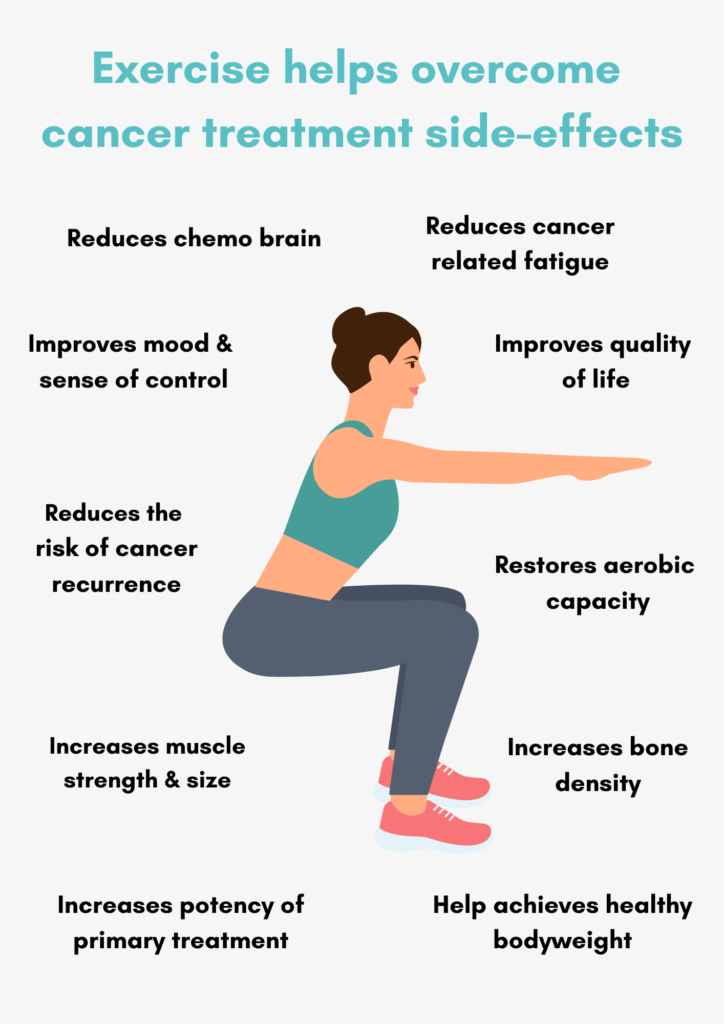It’s vital to discuss the beneficial role exercise plays with regards to your cancer treatment journey. With over 400 Australians diagnosed with cancer every day, it is imperative to adopt a holistic approach to the management of cancer to ensure the best possible outcomes.
Unfortunately however, considering the vast amount of research supporting exercise for the management of cancer, prescribed physical activity is still often viewed as an ‘optional extra’ despite benefits throughout the disease spectrum in such patients. Exercise should be ‘standard of care’ for all cancer patients.
The need for exercise is perhaps best summed up by Professor Rob Newton of Edith Cowan University:
“Avoid a rest strategy.
No matter what the cancer, what the stage of treatment, you must engage in regular physical activity, otherwise the outcome will be far worse.”
So what does the research show?
In men with prostate cancer…
Men who performed more than 3 hours per week of vigorous activity after prostate cancer diagnosis had a:
- 49% lower risk of all-cause mortality,
- 61% lower risk of prostate cancer mortality (1).
Similar benefits are seen in patients with breast cancer…
Evidence from observational studies suggests a reduced risk of breast cancer death of:
- 20-50% if physically active, and a
- reduced risk of breast cancer recurrence of 17-43% if physically active (2).
Exercise is Medicine
Exercise is still viewed as an ‘optional extra’ despite benefits across disease spectrum in cancer patients. Exercise should be ‘standard of care’ for all patients.
People affected by cancer often have other health conditions, therefore it is very important for these individuals to avoid being physically inactive. However, research shows that 62% of people with cancer are insufficiently active or sedentary (3). This inactivity can exacerbate and potentially worsen your recovery prospects.
Synergistic Medicine
Exercise can be provided simultaneously with primary therapies to help increase tolerance and reduce, prevent or reverse side-effects associated with treatment. It can even help to improve the effectiveness and potency of your primary treatment, be it chemotherapy or hormone replacement therapy. Exercise helps stimulate a stronger immune response to enhance your body’s ability to win the fight against cancer, along with:
- Increasing muscle mass and strength,
- Maintaining and even improving bone mass and strength,
- Decreasing fat tissue to improve body composition,
- Improving physical function and capacity,
- Decreasing anxiety and distress,
- Improving sleep quality,
- Decreasing depression,
- Decreasing risk of developing other cancers,
- Improving quality of life.

“Training with Luke during the last three years of post cancer recovery has been hugely helpful.
Luke designs workout programs around my various challenging side effects of treatment. He is kind, patient and accommodating of bad days while looking for improvements and setting increasing goals. Never having been a gym bunny I am surprised how much I actually enjoy our sessions and the sense of achievement on the good days which are increasingly frequent. Luke’s specialised knowledge of exercise after cancer treatment is reassuring and I have confidence in ongoing improvements to my health and wellbeing as strength and stamina continue to improve.
Although I am only using tiny weights thus far, am in my 60’s and rather frail, I do not find the gym at all intimidating. Everyone just does their own thing. It really is for everyone.”
Jennifer, aged 60
Current Exercise Recommendations
It is recommended that exercise be combined with your primary therapy to enhance it’s effectiveness and off-set potential side-effects. At Restart, we often see patients who are undergoing:
- Pre and post-surgery,
- Radiotherapy,
- Chemotherapy,
- Hormone therapy,
- Immunotherapy.
The current exercise recommendations are to:
- Engage in regular physical activity,
- Avoid inactivity and be as physically active as abilities and conditions allow,
- Aim to achieve at least:
- 150 minutes of moderate intensity aerobic exercise, or
- 75 minutes of vigorous intensity aerobic exercise per week,
- Include resistance exercise 2-3 days per week.
Of course, there will likely be days when the desire to exercise is not there. On these days, remembers the mantra – any amount of movement will be better than nothing, and something more is better than less. This might mean completing a 5 minute walk on those flat days, and engaging in a more intense strength-training workout on more energetic days.
As Exercise Physiologists, we can help guide you on the best movements for you and your stage of treatment.
Should I exercise if I my cancer has metastasised?
A 2011 Western Australian study on the effectiveness and safety of exercise in prostate cancer patients with bone metastases reported no major adverse events or bone pain in relation to the intervention (exercise). The study concluded that exercise improved self-reported physical function compared to controls (5).
Patients with bone metastases can and should exercise, however must always be supervised. Current recommendations are to avoid loading the areas of bones with lesions, but this may change in the near future once further research is done to establish safe load limits.
“I believe that exercise helped in reducing my fatigue levels during chemotherapy, however I would still have to take it easy. Interestingly, I noticed that people that were not engaging in regular exercises appeared to be more fatigued than I was during the course of the treatment. When it came to tolerating chemo, a lot of people undergoing treatment at the same time as me would miss treatment sessions due to low blood cell counts and thus have their dosage altered. I managed to get through the whole bout of chemo without missing any sessions or changing any chemo doses.
Additionally, during chemo I did get a lot of muscle soreness, and stretching with my Exercise Physiologist helped reduce these symptoms, especially lower back pain. These benefits helped solidify my reasoning behind making the effort to regularly get to the gym and see an Exercise Physiologist.”
Rachel, aged 34
At Restart, we accept:
- Chronic Disease Management (CDM) Medicare referrals for cancer patients, which allow for up to five subsidised appointments per calendar year;
- Enquiries without a specified referral, which can be utilised along with private health insurance rebates.
We understand that navigating your cancer treatment journey can be overwhelming for a variety of reasons. Utilising the medicinal benefits of exercise is an important strategy to not only include, but to also get 100% right. Our team will factor in all aspects of your current primary treatment, existing treatment side-effects, your current capacity and energy levels, and physical activity preferences, to design the best movement program for you to get you through the challenging times ahead.
Luke
References
1) Kenfield et al, Physical activity and survival after prostate cancer diagnosis in the health professionals follow-up study. Journal of Clinical Oncology, 2011.
2) Holmes, M.D., Chen, W.Y., Feskanich, D., Kroneke, C.H. & Colditz, G.A. (2005). Physical activity and survival after breast cancer diagnosis. 293(20). 2479-2486. doi:10.1001/jama.293.20.2479.
3) Ogle K.S., Swanson, G.M., Woods, N., Azzouz, F. (2000) Cancer and Comorbidity: redefining chronic diseases 88 (3) 653-63. Retrieved May 15, 2012 from http;//www.ncbi.nlm.nih.giv/pubmed/10649261
4) Hardee et al. The effect of resistance exercise on all-cause mortality in cancer survivors, Mayo Clin Proc. 2014;89(8):1108-1115
5) Galvao et al. Efficacy and safety of a modular multi-modal exercise program in prostate cancer patients with bone metastases: a randomised controlled trial. BMC Cancer 2011; unpublished data.

0 Comments